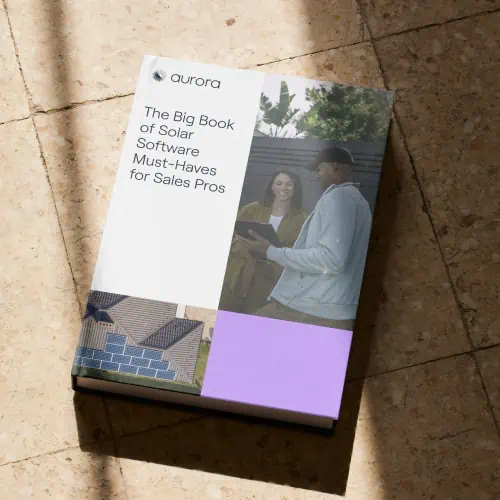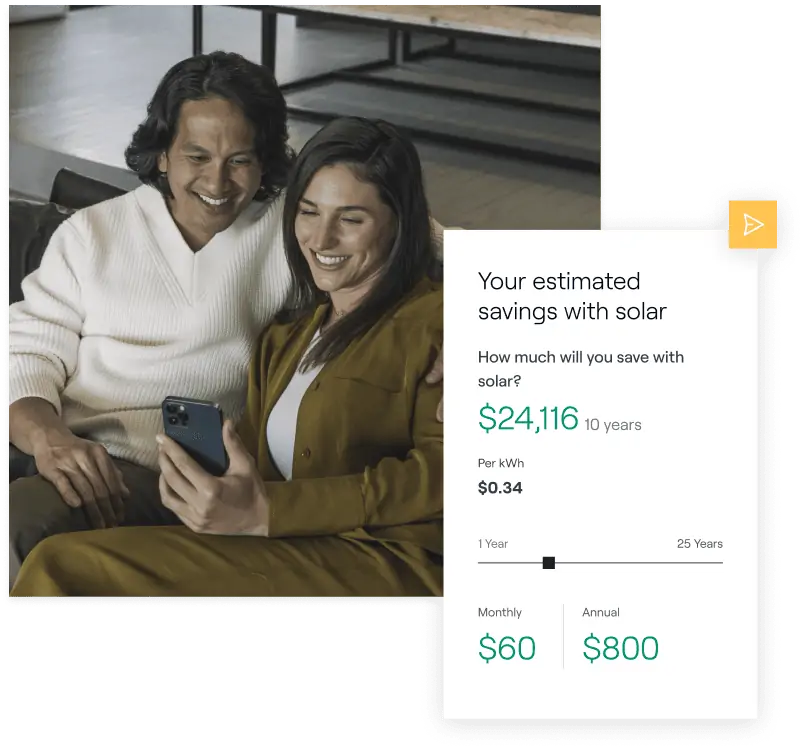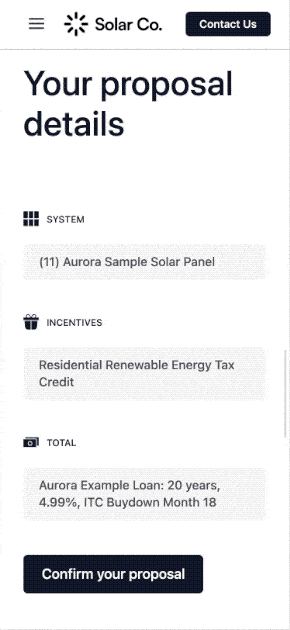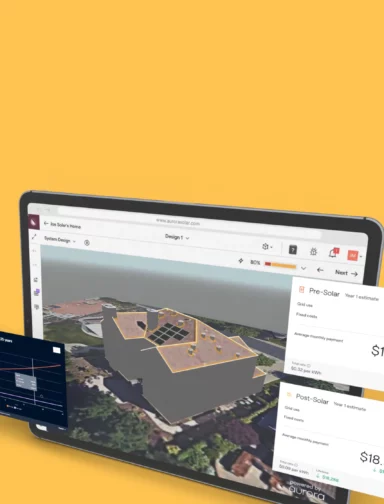Door-to-door canvassing is a longstanding sales tool. You can imagine early Roman salespeople knocking on doors, hoping the person that answers is interested in a new olive-oil powered lamp.
Door-to-door continues to be a popular sales method for residential solar — even through the pandemic — for one simple reason: It can be very effective.
But, just because it can be effective, doesn’t mean it’s easy.
In fact, today’s direct marketing pros can expect just about one in every four door-to-door contacts to listen to their entire sales pitch. What’s more? Only two percent result in a sale.
With the homeowner’s waning attention on the line, every second counts when building customer confidence and attempting to sell your services before a competitor seizes the opportunity. Empowering your teams to create accurate, personalized, compelling solutions in front of prospective customers, right on their doorstep, can be the difference between getting the sale started and a polite, “No thank you.”

Here are five key ways our research shows that you can close more business with your door-to-door efforts.
Quickly calculate the ideal system size
While solar systems are purchased for many reasons, it’s important to remember that homeowners will generally only invest in panels if it makes financial sense.
By introducing solar as an alternative to existing utility bills, you can grab a customer’s interest with the idea of saving money while you use the consumption information they provide to quickly calculate the ideal system size.
There’s a potential problem, though: In most scenarios, homeowners only have a general idea of their electric utility expenses.
As Aurora Solar Product Marketing Manager Stephen Gerken explained:
“It’s pretty safe to assume that the homeowner won’t have their last year’s worth of electricity bills right at the ready, but it is likely that they’ll know what they paid last month, or have a rough estimate of what their average bill looks like.”
Thankfully, Sales Mode AI can accurately estimate average daily, monthly, and annual electricity consumption and expenses with a bare minimum of input from the customer — one month’s electricity cost — based on other homes in their area.
With just this information, you can show them how their electricity bills will increase over time, and present a personalized solar energy system to help them offset this.

Generate a site design on the spot
The next step to a successful one-knock close is to create an accurate, personalized site design that shows where solar can be installed to meet production goals.
By inputting the homeowner’s street address right into their tablet, canvassers can use Sales Mode AI’s up-to-date HD satellite imagery to instantly locate a property anywhere in the country and generate an accurate, interactive site design with a few simple taps.

“In less than thirty seconds, Aurora’s AI generates a full 3D model, including all of the roof obstructions, with everything already snapped to the correct height and pitch, so you don’t need to guesstimate,” Stephen explained.
This is a stark contrast to most other proposal tools, which only provide 2D designs and require you to estimate the roof pitch and shading — sometimes using a tool like a sliding scale. Aurora automatically takes that into account, so the sales rep doesn’t need to worry about it and can have confidence that it’s accurate.
To reduce the likelihood of change orders, Sales Mode lets solar companies do things like preloading the panel setback configurations that are enforced by local jurisdictions — eliminating a big cause of errors.
Combining speed and attention to detail, utilizing a digital, on-the-spot site design tool like Sales Mode AI enables sales reps to move the conversation forward on the spot, without having to wait for a proposal to be delivered later.
Fully showcase the solar potential
Now that the home is mapped and ready, the third step to a one-knock close is to quite literally let the sun shine on a potential solar energy system.
After accounting for additional shading from trees, neighboring structures, and other obstructions, homeowners can learn the exact amount of sunlight that every square foot of their property receives each day of the year with Sales Mode AI’s irradiance data and sun path animations.
Using this information and Aurora Solar’s easy panel placement tools, sales reps can then introduce various solar options — again, right on their tablet — while walking customers through each system design in real time.

After working together to find the ideal parts and placement, reps can then project the system’s electricity generation potential over the lifespan of the installation. It’s important to note here that it’s critical that Aurora’s technology is designed to make these projections dead-on accurate. Installers using less accurate projection systems often find that production is way off of what they quoted the homeowners. This leads to a lot of customer complaints coming in 6 months to a year later along the lines of, “Hey I’m still paying way more than you said I would for electricity!” You can imagine what this does to any potential referrals.
When considering most solar panels have warranties between 20-30 years, sales reps can easily circle back and compare the customer’s expected electricity costs over the same period of time.
Using Sales Mode AI’s auto-generated local utility information, the price of solar can then be compared, apples-to-apples, against long-term grid power consumption.
Make changes to the proposal in real-time
 Perhaps more than anything else, addressing customer objections and making changes to a proposal in real-time with instant personalization can help you close more solar sales.
Perhaps more than anything else, addressing customer objections and making changes to a proposal in real-time with instant personalization can help you close more solar sales.
Knowing that 80% of customers are more likely to do business with a company that can offer a personalized experience, every detail that is tailored to that specific customer will increase the likelihood of a one-knock close.
And while there are an infinite number of questions that can help create value, successful solar sales reps will typically find out:
- If there are any HOAs or personal preferences that restrict solar panel placement
- Whether home electricity usage is expected to rise (i.e. new air conditioning or an electric car)
- If the homeowner would like to consider a battery backup as part of the system
By adapting your solar energy services in real-time, customers will be less likely to seek additional information from another provider.
“It’s important to get the homeowner involved and ask what they want. After all, this is their design, so they’re more likely to move forward if they feel involved in the process,” Stephen concludes
Once the design is completed, proposal adjustments can continue into the financing conversation — we all know that the 11th hour can be a great time to introduce discounts, rebates, and incentives that are available for qualified customers.
Create and send an accurate contract
Finally, once you’ve created the best possible solar energy system for a particular customer, demonstrated its value, and discussed purchasing options, it’s time to put the power in the hands of the homeowner.
That brings us to the fifth step of a successful one-knock close: creating and sending an accurate, ready-to-sign contract.
In this crucial step, Sales Mode is built to minimize errors by pre-populating all of the customer and system data from the proposal directly into the contract. Complete with e-signature integration, Aurora’s Contract Manager enables solar companies to instantly create error-free contracts that are ready-to-sign or print.
And while a true “one-knock close” implies a signature on-the-spot, many homeowners will need more time to consider an investment in solar. Whether they simply want to weigh their options or would like to share the information with a family member, sales reps can still close the deal after the initial meeting.
By sending documentation — including a visually compelling proposal — and staying in communication, the sales process can then continue on the homeowner’s own schedule.
If any design or contract changes are required, you can make the adjustments remotely in Sales Mode, and just send an updated proposal link to the customer.

In closing…
Working with a customer on location, door-to-door solar sales reps that have the right tools and tech are already one step ahead of their competition.
By including everything necessary to generate new business, Sales Mode can help companies increase their one-knock close rates with fast, accurate, and personalized system designs, proposals, and contracts, all created directly in front of the customer.

To learn more about how Sales Mode can help your business, schedule a quick, personalized demo.
Featured image by Dim Gunger.


